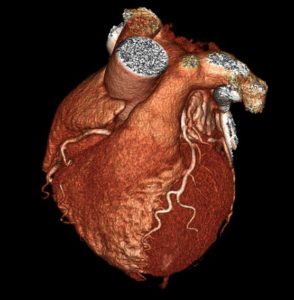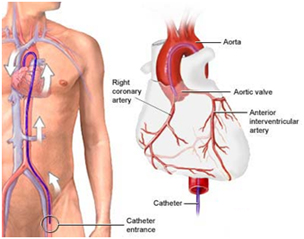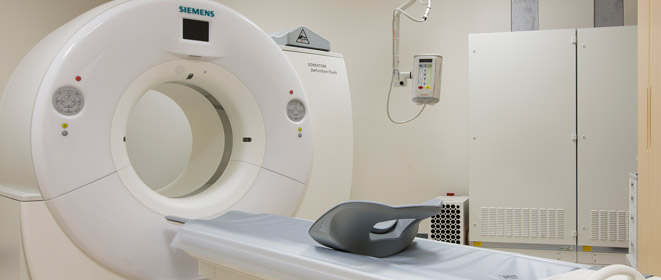Coronary Computed Tomography Angiography (CCTA)
Coronary computed tomography angiography (CCTA) uses an injection of iodine-rich contrast material and CT scanning to examine the arteries that supply blood to the heart and determine whether they have been narrowed by plaque buildup. The images generated during a CT scan can be reformatted to create three-dimensional images that may be viewed on a monitor, printed on film, or transferred to electronic media.
Tell your doctor if there’s a possibility you are pregnant and discuss any recent illnesses, medical conditions, medications you’re taking, and allergies. You will be instructed not to eat or drink anything several hours beforehand and to avoid caffeinated products, Viagra or similar medication. If you have a known allergy to contrast material, your doctor may prescribe medications to reduce the risk of an allergic reaction. These medications must be taken 12 hours prior to your exam. Leave jewelry at home and wear loose, comfortable clothing. You may be asked to wear a gown. If you are breastfeeding, talk to your doctor about how to proceed.
 |
What are some common uses of the procedure?
Many physicians advocate the careful use of CCTA for patients who have:
- suspected abnormal anatomy of the coronary arteries.
- low or intermediate risk for coronary artery disease, including patients who have chest pain and normal, non-diagnostic or unclear lab and ECG results.
- low to intermediate risk atypical chest pain in the emergency department.
- non-acute chest pain.
- new or worsening symptoms with a previous normal stress test result.
- unclear or inconclusive stress test results.
- new onset heart failure with reduced heart function and low or medium risk for coronary artery disease.
- intermediate risk of coronary artery disease before non-coronary cardiac surgery.
- coronary artery bypass grafts.
For patients meeting the above indications, CCTA can provide important information about the presence and extent of plaque in the coronary arteries. Apart from identifying coronary artery narrowing as the cause of chest discomfort, it can also detect other possible causes of symptoms, such as a collapsed lung, blood clot in the vessels leading to the lungs, or acute aortic abnormalities. Your primary care physician or cardiac specialist, possibly in consultation with a radiologist who would perform the test, will determine whether CCTA is appropriate for you.
Benefits
- CCTA is not invasive. An alternative test, cardiac catheterization with a coronary angiogram, is invasive, has more complications related to the placement of a long catheter into the arteries and the movement of the catheter in the blood vessels, and requires more time for the patient to recover.
- A major advantage of CT is that it is able to view bone, soft tissue and blood vessels all at the same time. It is therefore suited to identify other reasons for your discomfort such as an injury to the aorta or a blood clot in the lungs.
- Unlike conventional x-rays, CT scanning provides very detailed images of many types of tissue.
- CT examinations are fast and simple.
- CT has been shown to be cost-effective for a wide range of medical problems.
- CT is less sensitive to patient movement than MRI.
- CT can be performed if you have an implanted medical device of any kind, unlike MRI.
- No radiation remains in a patient’s body after a CT examination.
- X-rays used in CT scans should have no immediate side effects.
Risks
- In some people with abnormal kidney function, the dye used in CT scanning may worsen kidney function.
- If a large amount of x-ray contrast material leaks out from the vessel being injected and spreads under the skin where the IV is placed, skin damage or damage to blood vessels and nerves, though unlikely, can result. If you feel any pain in your arm at the location of the IV during contrast material injection, you should immediately inform the technologist.
- There is always a slight chance of cancer from excessive exposure to radiation. However, the benefit of an accurate diagnosis far outweighs the risk.
- The effective radiation dose for this procedure varies. See the Safety page for more information about radiation dose.
- Women should always inform their physician and x-ray or CT technologist if there is any possibility that they are pregnant. See the Safety page for more information about pregnancy and x-rays.
- CT scanning is, in general, not recommended for pregnant women unless medically necessary because of potential risk to the fetus in the womb.
- Manufacturers of intravenous contrast indicate mothers should not breastfeed their babies for 24-48 hours after contrast medium is given. However, both the American College of Radiology (ACR) and the European Society of Urogenital Radiology note that the available data suggest that it is safe to continue breastfeeding after receiving intravenous contrast. For further information please consult the ACR Manual on Contrast Media and its references.
- The risk of serious allergic reaction to contrast materials that contain iodine is extremely rare, and radiology departments are well-equipped to deal with them.
 Vikas Diagnostics Best Diagnostics Lab In Kanpur
Vikas Diagnostics Best Diagnostics Lab In Kanpur



